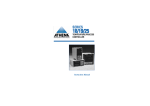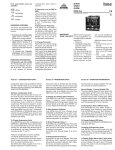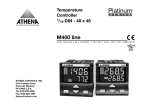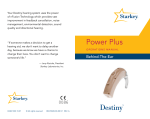Download Athena Point 5 Series P.5 Instruction manual
Transcript
SERIES OTC25-N/L/P TEMPERATURE CONTROLLER Instruction Manual Introduction Features Congratulations on your purchase of an Athena Series OTC25 Digital Temperature Controller. It is designed for ease of use and reliability wherever accurate temperature control is required. • Type J Input (OTC25 N, OTC25 L) • Type J or K Input (OTC25 P) • ±0.3% FS Accuracy • Large, Easy-to-Read LED Display, Selectable for Either Setpoint or Process Temperature After following the instructions for installation, simply step through and set each of the unit’s parameters using the OTC25’s easy menu system. • Adjustable Output Hysteresis to Prevent Rapid Cycling Around Setpoint Temperature (OTC25 N) If you still have questions or require any assistance in setting up or operating your controller, please contact your Athena representative or call 1-800-782-6776. • Adjustable Deviation Alarm Flashes Display When Measured Temperature Exceeds or Falls Below Setpoint Temperature • NEMA 4X Front Bezel, Splash-Proof and Resistant to Dust • Discrete Status Indicators Illuminate When Temperature Display, Setpoint Display or Heat/Cool Output is Active Safety Warning • Approvals: UR, cUR, CE In addition to presenting a potential fire hazard, high voltage and high temperature can damage equipment and cause severe injury or death. When installing or using this instrument, follow all instructions carefully and use approved safety controls. Electrical connections and wiring should be performed only by suitably trained personnel. © Copyright 1996, Athena Controls, Inc. i Do not locate this instrument where it is subject to excessive shock, vibration, dirt, moisture, oil, or other liquids. The safe operating temperature range for this unit is 32° F to 140° F (0° C to 60° C). ii Table of Contents Installation Installation Mounting Wiring Operation 1 2 3 OTC25 N On/Off Controller OTC25 L Limit Controller OTC25 P PID Controller 4 6 10 13 Calibration Error Codes IEC Requirements Warranty/Repair Information Technical Specifications 18 20 21 22 25 Pre-Installation Instructions 1. Inspect shipping carton for obvious signs of mishandling. 2. After removing the controller from the shipping carton, inspect it carefully for damage. Never attempt to install and use a damaged unit. 3. Verify that the ordering code number indicated on the side of the controller matches what was ordered. Figure 1. Case Dimensions Prior to mounting the OTC25 in your panel, make sure that the cutout opening is of the right size, 3.622" x 3.622" (92 mm x 92 mm), and deburred to enable a smooth fit. A minimum of 5.0" (127.0 mm) of depth behind the panel is required. iii 1 Mounting Wiring Figure 2. Mounting Diagram IMPORTANT: All electrical wiring connections should be made only by trained personnel using Class 1 wiring, and in strict accordance with the National Electrical Code and local regulations. Both of the incoming power lines should be fused with 2AG, 0.5 A maximum rated fuses. The OTC25 controller has built-in circuitry to reduce the effects of electrical noise (RFI) from various sources; however, power and signal wires should always be kept separate. We recommend separating wires into one bundle for power (from line power and output) and one bundle for signal (from thermocouple). Before installing OTC25, ensure gasket seats evenly around edges of unit and that there are no breaks or tears in the gasket. The OTC25 power supply accepts 100 through 250 Vac and 120 through 250 Vdc line power without any switch settings or polarity considerations. Insert the OTC25 through the front panel cutout, slide mounting “U” bracket around unit and secure it with the screws provided. Gasket should be evenly compressed around all sides to provide liquid-tight mounting. Figure 3. Wiring Connections 2 3 Operation Operation Athena Series OTC25 Digital Temperature Controller Just a few easy steps are required before your OTC25 can be placed into service. After completing the mounting and wiring procedures as previously instructed, set each controller parameter using the simple front-panel keys as instructed. Three-Digit LED Display Displays measured temperature, setpoint, or parameter labels and settings. Power On When power is first applied to the OTC25, all segments of the LED display, as well as the discrete indicators, will be momentarily illuminated while the instrument goes through a series of diagnostic checks to verify proper operation of the unit. A software version will then be displayed, e.g., . The last two digits of this code indicate the software revision supplied with your controller. Please provide this revision number when contacting us regarding your unit. This display is followed by a mnemonic code representing the OTC25 model type. Figure 4. Front Panel Controls and Indicators Parameter Key Used to access available parameters to set or change values. Raise Key Used to scroll up through available parameter settings or to increase values. (Hold for fast-step progression) Lower Key Used to scroll down through available parameter settings or to decrease values. (Hold for fast-step progression) Discrete LED Indicators OTC25 N OTC25 L Actual: amber Actual: amber Setpoint: amber Setpoint: amber Heat: orange Limit: orange 4 OTC25 P Actual: amber Setpoint: amber Output 1: orange Output 2: orange 5 OTC25 N Operation OTC25 N Operation OTC25 N On/Off Temperature Controller The Calibration High and Calibration Low selections are accessible only when the calibration jumper is installed as instructed on page 18 (Figure 6). Normal Operation The factory default display setting of the OTC25 N is for Actual Temperature . The default display may be changed to setpoint temperature by selecting Setpoint at the Default Display parameter selection. When the Default Display is changed to Setpoint, the setpoint temperature may be adjusted by using the Raise or Lower keys. The setpoint is adjustable from 32 to 905° F (0 to 485° C). When the Default Display setting is “Actual” , adjustment of the Setpoint may only be accomplished by pressing the Parameter Key momentarily to switch the display to Setpoint, and then using the Raise or Lower Keys to change the Setpoint Value. The display will automatically revert back to “Actual” five seconds after the last keypress. Parameter Configuration Your OTC25 N controller’s parameter selections are explained on the next page, with default settings shown in Figure 5a. To enter the configuration menu, press and hold the Parameter key for 10 seconds until the display changes to the parameter mode. Press the Parameter key again to index through the available parameters. Pressing the Parameter Key for 3 seconds or allowing 60 seconds of inactivity will cause the OTC25 N to exit the menu system and return to normal operating mode. 6 Figure 5a. Series OTC25 N Parameters and Default Settings Parameter Descriptions Default Display This parameter determines whether the OTC25 N’s display shows the Setpoint or the actual temperature by default. Regardless of the selection made here, the operator can 7 OTC25 N Operation OTC25 N Operation observe the other value by momentarily pressing the Parameter Key. This will cause the alternate value to be displayed for five seconds. Control Hysteresis is adjustable between 2 and 252° F (1 to 140° C ). This parameter is used by the control algorithm to prevent rapid cycling of the output around Setpoint. The default value is 4° F (2° C). This means the heat will turn OFF when the Actual Temperature exceeds the Setpoint by 2° F (1° C). Conversely, the heater will not turn ON until the Actual Temperature drops 2° F (1° C) below the Setpoint. A Deviation Band is a pre-set number of degrees, plus and minus, around the Setpoint Value, ex. +10° F. A Deviation Band Alarm provides an indication to the operator that the Actual Temperature has either exceeded or dropped below the chosen deviation. This parameter can be turned off or adjusted from 1 to 252° F (1 to 140° C). When the process variable is outside the deviation band, the alarm is indicated by flashing the display (regardless of whether setpoint or actual temperature is displayed) and the optional alarm output is activated. Display Offset Display Units Display Offset is adjustable from -126 to 126° F (-70 to 70° C). It can be used to provide limited adjustment of the displayed temperature as a compensation for offsets between the true temperature and the temperature seen by the thermocouple. This allows the operator to have the display indicate either degrees Fahrenheit or degrees Celsius. Control Hysteresis 8 Deviation Band Alarm 9 OTC25 L Operation OTC25 L Operation OTC25 L Limit Controller Normal Operation The factory default display setting of the OTC25 L is for Actual Temperature . The default display may be changed to setpoint temperature by selecting Limit Setpoint at the Default Display parameter selection. When the Default Display is changed to Limit Setpoint, the limit setpoint temperature may be adjusted by using the Raise or Lower keys. The limit setpoint is adjustable from 32 to 905° F (0 to 485° C). When the Default Display setting is “Actual” , adjustment of the Limit Setpoint may only be accomplished by pressing the Parameter Key momentarily to switch the display to Limit Setpoint, and then using the Raise or Lower Keys to change the Limit Setpoint Value. The display will automatically revert back to “Actual” five seconds after the last keypress. Parameter Configuration Your OTC25 L controller’s parameter selections are explained on the next page, with default settings shown in Figure 5b. To enter the configuration menu, press and hold the Parameter key for 10 seconds until the display changes to the parameter mode. Press the Parameter key again to index through the available parameters. Pressing the Parameter Key for 3 seconds or allowing 60 seconds of inactivity will cause the OTC25 L to exit the menu system and return to normal operating mode. 10 Figure 5b. Series OTC25 L Parameters and Default Settings Parameter Descriptions Default Display This parameter determines whether the OTC25 L’s display shows the Limit Setpoint or the actual temperature by default. Regardless of the selection made here, the operator can observe the other value by momentarily pressing the Parameter Key. This will cause the alternate value to be displayed for five seconds. 11 OTC25 L Operation OTC25 P Operation Limit Setpoint The Limit Setpoint determines the temperature at which the limit output will become inactive, interrupting power to the process. It is operator-selectable from 32° to 905° F (0° to 485° C). Automatic Startup Reset The automatic startup reset feature allows the limit output to be automatically reset at startup or to be latched at startup. In the latter condition, the limit output will have to be manually reset before the limit output will be activated (relay closed allowing power to flow to process heaters or coolers). Display Units This allows the operator to have the display indicate either degrees Fahrenheit or degrees Celsius. OTC25 P PID Temperature Controller Normal Operation The factory default display setting of the OTC25 P is for Actual Temperature . The default display may be changed to setpoint temperature by selecting Setpoint at the Default Display parameter selection. When the Default Display is changed to Setpoint, the setpoint temperature may be adjusted by using the Raise or Lower keys. The setpoint is adjustable from 0 to 999° F (-17 to 537° C). When the Default Display setting is “Actual” , adjustment of the Setpoint may only be accomplished by pressing the Parameter Key momentarily to switch the display to Setpoint, and then using the Raise or Lower Keys to change the Setpoint Value. The display will automatically revert back to “Actual” five seconds after the last keypress. Parameter Configuration Your OTC25 P controller’s parameter selections are explained on the next page, with default settings shown in Figure 5c. To enter the configuration menu, press and hold the Parameter key for 10 seconds until the display changes to the parameter mode. Press the Parameter key again to index through the available parameters. Pressing the Parameter Key for 3 seconds or allowing 60 seconds of inactivity will cause the OTC25 P to exit the menu system and return to normal operating mode. 12 13 OTC25 P Operation OTC25 P Operation Figure 5c. Series OTC25 P Parameters and Default Settings Parameter Descriptions Default Display This parameter determines whether the OTC25 P’s display shows the Setpoint or the actual temperature by default. Regardless of the selection made here, the operator can observe the other value by momentarily pressing the Parameter Key. This will cause the alternate value to be displayed for five seconds. Display Offset Display Offset is adjustable from -126 to 126° F (-70 to 70° C). It can be used to provide limited adjustment of the displayed chart continued on next page 14 15 OTC25 P Operation OTC25 P Operation temperature as a compensation for offsets between the true temperature and the temperature seen by the thermocouple. Proportional Band Proportional Band is a PID parameter that represents the amount of deviation of the controlled variable required to move through the full range, expressed in % of span or degrees of temperature. This parameter can also be expressed as “Gain” (the wider the band, the lower the gain). Rate Rate is a PID parameter (Derivative Action) that produces a corrective signal proportional to the rate at which the controlled variable is changing. It is used to correct for overshoot and undershoot. Reset Reset is a PID parameter (Integral Action) that produces a corrective signal proportional to the length of time and magnitude that the controlled variable has been off setpoint. It is used to accommodate load changes. Heat Cycle Time Heat Cycle Time is displayed in seconds, and can be set from 0 to 120 seconds. A setting of zero represents a heat cycle time of 300 milliseconds. Cool Cycle Time Cool Cycle Time is displayed in seconds, and can be set from 16 0 to 120 seconds. A setting of zero represents a cool cycle time of 300 milliseconds. This menu parameter will only be displayed if output 2 is configured to be a cool output. Deviation Band Alarm A Deviation Band is a pre-set number of degrees, plus and minus, around the Setpoint Value, ex. +10° F. A Deviation Band Alarm provides an indication to the operator that the actual temperature has either exceeded or dropped below the chosen deviation. This parameter can be turned off or adjusted from 1 to 252° F (1 to 140° C). When the process variable is outside the deviation band, the alarm is indicated by flashing the display (regardless of whether setpoint or actual temperature is displayed and activating an output, if configured as such). Output 2 Configuration Output 2 may be configured as either a control output or as an alarm output for the deviation band alarm. When configured for control, output 2 acts as a cool PID output. When configured for an alarm, output 2 is activated when the deviation alarm is active and deactivated when the deviation alarm is inactive. Display Units This allows the operator to have the display indicate either degrees Fahrenheit or degrees Celsius. Input Type Sensor input type may be either a Type J or Type K thermocouple. 17 Calibration Calibration Calibration The Calibration High and Calibration Low selections are accessible only when the calibration jumper is installed (Figure 6). , Calibration of the OTC25 controller requires the operator to apply two separate fixed and specific signals (Calibration Low and Calibration High) from a reference source (thermocouple calibrator) to the controller. The Raise Key “tells” the controller to read the applied signal and use it as a reference point. Calibration Procedure 1. Prior to applying power to the unit, install the calibration jumper on the microprocessor board as shown in Figure 6. 2. With the instrument still unpowered, connect a calibration reference source to the thermocouple input terminals on the OTC25. 3. Apply power. Allow at least 15 minutes for the controller to warm up before continuing. 4. Using the Parameter Key, index to the Calibration Low parameter. The display will alternately flash this mnemonic and the number “32” (“0” for Celsius units). 5. Adjust the reference source to output a voltage equivalent to that generated by a “J” or “K” (OTC25 P) thermocouple at 32° F (0° C). Allow reference to settle for 10 seconds before proceeding. Figure 6. Location of Calibration Jumper. 6. Press the Raise key once to set this reference point. The display will stop flashing momentarily while the controller self-calibrates (approx. 3 seconds), and then resume flashing. 7. Press the Parameter Key, index to the Calibration High parameter. The display will alternately flash this mnemonic and the temperature value it expects to see. 18 19 IEC Requirements Calibration 8. Adjust the reference source to output a voltage equivalent to that generated by a “J” or “K” (OTC25 P) thermocouple at the temperature flashing on the display. (Allow reference to settle for 10 seconds before proceeding.) The maximum supply current is line voltage dependent: 9. Repeat Step 6 for this reference point. 60 mA for an 100-250 Vac input 10. Press the Parameter Key for 10 seconds or allow 60 seconds of inactivity. 11. Adjust the reference source to output a voltage equivalent to that generated by a “J” or “K” (OTC25 P) thermocouple at 32° F (0° C). Verify that (after settling), the OTC25 indicates a measured temperature of 32° F (0° C). 12. Repeat Step 11 for the upper reference point. Error Codes fuse rating: 2AG, 0.5 A Output Specifications Output 1 Type T (Triac) B (Relay) Max current 2A 5A Voltage 400 Vpk 380 V Leakage 1 mA — Output 2 Type T (SSR) B (Relay) Max current 0.5 A 5A Voltage 400 Vpk 380 V Leakage 1 mA — CLEANING INSTRUCTIONS Display 20 USE OF THIS EQUIPMENT IN A MANNER NOT SPECIFIED BY THE MANUFACTURER MAY IMPAIR PROTECTION PROVIDED BY THE EQUIPMENT! Problem Possible Solution Broken thermocouple lead wire or defective sensor. Verify wiring. Replace sensor. Input Signal is below calibration of unit. Verify Input Signal; check calibration. 1. Remove power from the unit prior to any cleaning operation. 2. Use a cotton cloth to gently and sparingly apply isopropyl alcohol only. Do not use cleaners or other solvents as they may damage the unit. 3. Allow the unit to dry completely prior to reapplying power. 21 Warranty/Repair Information Warranty/Repair Information Two-Year Limited Warranty THIS EQUIPMENT IS WARRANTED TO BE FREE FROM DEFECTS OF MATERIAL AND WORKMANSHIP. IT IS SOLD SUBJECT TO OUR MUTUAL AGREEMENT THAT THE LIABILITY OF ATHENA CONTROLS, INCORPORATED IS TO REPLACE OR REPAIR THIS EQUIPMENT AT ITS FACTORY, PROVIDED THAT IT IS RETURNED WITH TRANSPORTATION PREPAID WITHIN TWO (2) YEARS OF ITS PURCHASE. THE PURCHASER AGREES THAT ATHENA CONTROLS, INCORPORATED ASSUMES NO LIABILITY UNDER ANY CIRCUMSTANCES FOR CONSEQUENTIAL DAMAGES RESULTING FROM ITS USE OR FROM IMPROPER HANDLING OR PACKAGING OF SHIPMENTS RETURNED TO THE FACTORY. COMPONENTS WHICH WEAR OR WHICH ARE DAMAGED BY MISUSE ARE NOT WARRANTED. THESE INCLUDE CONTACT POINTS, FUSES, ELECTROMECHANICAL RELAYS, AND TRIACS. UNITS WHICH HAVE BEEN MODIFIED BY A CUSTOMER IN ANY WAY ARE NOT WARRANTED. IN NEGLIGENCE OR OTHERWISE SHALL NOT EXCEED THE RETURN OF THE AMOUNT OF THE PURCHASE PRICE PAID BY THE PURCHASER AND UNDER NO CIRCUMSTANCES SHALL SELLER BE LIABLE FOR SPECIAL, INDIRECT, INCIDENTAL OR CONSEQUENTIAL DAMAGES. THE PRICE STATED FOR THE EQUIPMENT IS A CONSIDERATION IN LIMITING SELLER’S LIABILITY. NO ACTION, REGARDLESS OF FORM, ARISING OUT OF THE TRANSACTIONS OF THIS AGREEMENT MAY BE BROUGHT BY PURCHASER MORE THAN ONE YEAR AFTER THE CAUSE OF ACTION HAS ACCRUED. SELLER’S MAXIMUM LIABILITY SHALL NOT EXCEED AND BUYER’S REMEDY IS LIMITED TO EITHER (i) REPAIR OR REPLACEMENT OF THE DEFECTIVE PART OR PRODUCT, OR AT SELLER’S OPTION (ii) RETURN OF THE PRODUCT AND REFUND OF THE PURCHASE PRICE, AND SUCH REMEDY SHALL BE BUYER’S ENTIRE AND EXCLUSIVE REMEDY. THE SPECIFICATIONS PUT FORTH IN THIS MANUAL ARE SUBJECT TO CHANGE WITHOUT NOTICE. Other than those expressly stated herein, THERE ARE NO OTHER WARRANTIES OF ANY KIND, EXPRESS OR IMPLIED, AND SPECIFICALLY EXCLUDED BUT NOT BY WAY OF LIMITATION, ARE THE IMPLIED WARRANTIES OF FITNESS FOR A PARTICULAR PURPOSE AND MERCHANTABILITY. IT IS UNDERSTOOD AND AGREED THE SELLER’S LIABILITY WHETHER IN CONTRACT, IN TORT, UNDER ANY WARRANTY, 22 23 Warranty/Repair Information Technical Specifications Unit Repairs It is recommended that units requiring service be returned to an authorized service center. Before a controller is returned for service, please consult the service center nearest you. In many cases, the problem can be cleared up over the telephone. When the unit needs to be returned, the service center will ask for a detailed explanation of problems encountered and a Purchase Order to cover any charge. This information should also be put in the box with the unit. This should expedite return of the unit to you. This document is based on information available at the time of its publication. While efforts have been made to render accuracy to its content, the information contained herein does not purport to cover all details or variations in hardware, nor to provide for every possible contingency in connection with the installation and maintenance. Features may be described herein which are not present in all hardware. Athena Controls assumes no obligation of notice to holders of this document with respect to changes subsequently made. Proprietary information of Athena Controls, Inc. is furnished for customer use only. No other use is authorized without the written permission of Athena Controls, Inc. Operating Limits Ambient Temperature Relative Humidity Tolerance Power Sensor Range Type J Thermocouple Type K Thermocouple Performance Accuracy Setpoint Resolution Repeatability Temperature Stability TC Cold-End Tracking Noise Rejection Temperature Sampling Control Characteristics Control Hysteresis Display Offset 24 32° F to 140° F (0° C to 60° C) 20% to 95%, Non-Condensing 85 to 250 V ±10%, 50/60 Hz (Single-Phase) 120 to 250 Vdc OTC25 N/L: 6 to 926° F (-14 to 496° C) OTC25 P: 32 to 999° F (0 to 537° C) OTC25 P: 0 to 999° F (-17 to 537° C) ±0.3% of Full Scale (±0.10% Typical), ±1 Digit 1° F/C ±1 Count 5 µV /° C (Maximum) 0.05° C /° C Ambient 100 dB Common Mode, 70 dB Series Mode 3.7 Hz (270 ms) 2 to 252° F (1 to 140° C) -126 to 126° F (-70 to 70° C) 25 Technical Specifications Technical Specifications Mechanical Characteristics Display Display Height Color Front-Panel Cutout Bezel Outside Dimensions Bezel Height Case Depth Weight Connections Contacts Output Source (Power to Heater) 7-segment LED, alphanumeric: 3 digits 0.56" (14.22 mm) Orange 3.622" x 3.622" (92 mm x 92 mm) 3.780" x 3.780" (96 mm x 96 mm) 0.250" (6.35 mm) 3.515" (89.28 mm) < 15 oz (425 g) 7 “Fast-On” .250” (6.35 mm) Solid-State Relay (Output 1) 120/250 Vac, Zero-Voltage Switched, 2 A Continuous/ 10 A Surge @ 25° C Solid-State Relay (Output 2) 120/250 Vac, Zero-Voltage Switched, 0.5 A Continuous/ 10 A Surge @ 25° C Electromechanical Relay 5 A, 250 Vac/5 A, 30 Vdc Max Switching Capacity, 150 W Input Source (Temperature Sensor) Type J OTC25 N/L: OTC25 P: Type K 26 OTC25 N/L: OTC25 P: Thermocouple Range: 6 to 926° F (-14 to 496° C) 32 to 999° F (0 to 537° C) N/A 0 to 999° F (-17 to 537° C) 27 For Technical Assistance in the U.S., Call Toll Free: 1-800-782-6776 CORPORATE HEADQUARTERS EUROPE Athena Controls, Inc. 5145 Campus Drive Plymouth Meeting, PA 19462 U.S.A. Tel: (610) 828-2490 Fax: (610) 828-7084 Toll-Free in U.S.: 1-800-782-6776 Internet: www.athenacontrols.com Athena Controls, Ltd. Capitol Business Centre 60 Bramhall Lane South Bramhall, Stockport Cheshire, SK7 2DU, England Tel: +44 (0) 161 440 2522 Fax: +44 (0) 161 440 9322 E-mail: [email protected]



























